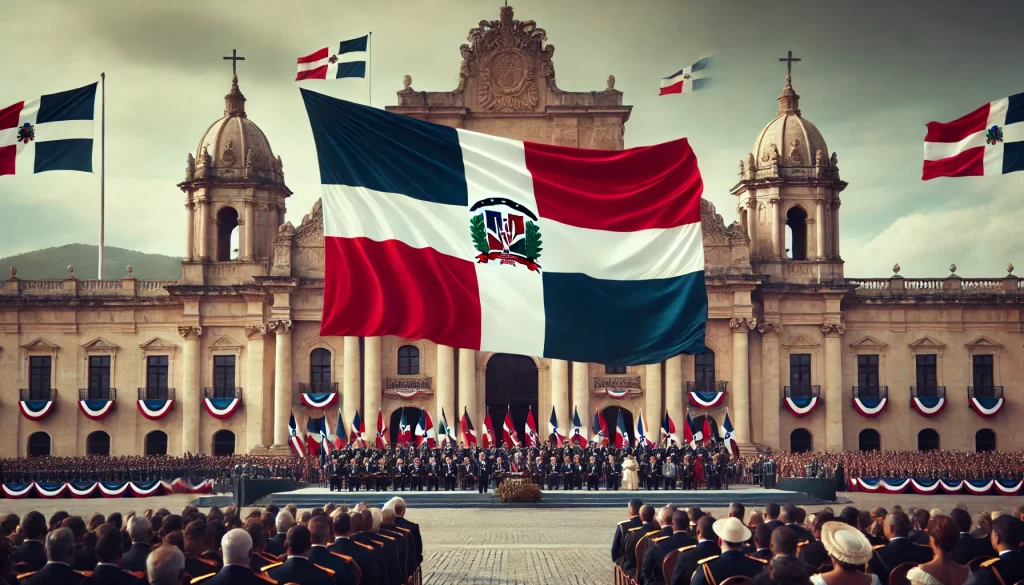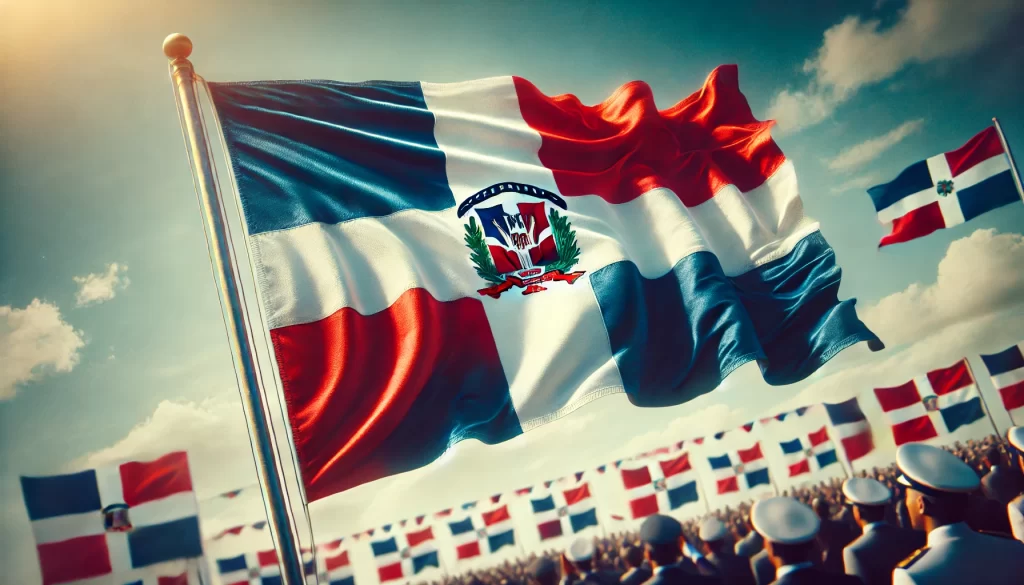Table of Contents
The Dominican Republic flag is not just a piece of fabric; it’s a powerful symbol of the nation’s history, culture, and values. This article explores the Dominican Republic flag in detail, unveiling the deep symbolism embedded in its design and its historical significance.
The Meaning Behind the Dominican Republic Flag

Understanding the Dominican Republic flag requires looking beyond its colors and shapes. Each element is carefully chosen to represent the nation’s values, history, and spirit.
Design Elements of the Flag
The Dominican Republic flag features a distinct design that carries multiple layers of meaning.
- White Cross: The flag’s central white cross divides it into four sections. This cross symbolizes the country’s Christian heritage and its historical struggle for freedom. It represents the unity and strength of the Dominican people in their fight for independence.
- Blue Rectangles: The blue rectangles on the flag symbolize the ideals of liberty and the hope for a bright future. They also stand for the Dominican people’s unwavering resolve to maintain their independence and sovereignty.
- Red Rectangles: The red rectangles signify the bloodshed during the struggle for independence and the sacrifices made by those who fought for freedom. This color also reflects the courage and determination of the nation’s founders.
- Coat of Arms: The national coat of arms is at the center of the flag, within the cross. This emblem includes a shield with a cross, a Bible, and other symbols that reflect the country’s deep-rooted Christian values and history. The coat of arms underscores the importance of faith and the sacrifices made for the nation’s liberty.
Historical Significance of the Flag
The design of the Dominican Republic flag is a tribute to the nation’s history and its fight for freedom.
- Origins and Adoption: The flag was officially adopted on November 6, 1844, shortly after the Dominican Republic gained independence from Haiti. Juan Pablo Duarte, one of the nation’s founding fathers, created the design to reflect the values and aspirations of the newly independent country.
- Influences and Adaptations: The Dominican Republic flag’s design was inspired by the French flag, yet it was adapted to incorporate unique elements that reflect the Dominican experience. The white cross and the use of specific colors were intended to represent the nation’s Christian faith and revolutionary spirit.
- Symbolic Evolution: Over time, the flag has come to symbolize not only the nation’s historical struggle but also its commitment to democracy and justice. The flag’s design has remained a constant reminder of the country’s values and the ongoing efforts to uphold them.
How the Flag Is Used Today

The Dominican Republic flag plays a significant role in the daily lives of its citizens and various national events. Its presence is a constant reminder of the country’s pride and unity.
Flag Etiquette and Display
Proper display and usage of the flag are important aspects of showing respect for its symbolism.
- Rules for Display: The Dominican Republic flag should be displayed on public buildings, during national holidays, and at official events. It should be treated with the utmost respect, never allowed to touch the ground, and not used for commercial purposes.
- Respectful Handling: The flag should be folded neatly and stored properly when handled. It should not be used as part of any costume or decoration that might diminish its significance.
Educational and Ceremonial Uses
The flag also plays a vital role in educational settings and official ceremonies.
- Educational Importance: Schools use the flag as a tool to teach students about their national heritage and values. It serves as a visual representation of the country’s history and the principles on which it was founded.
- Ceremonial Significance: During national ceremonies and events, the flag is prominently displayed to honor the country’s achievements and remember its history. It is a key element in celebrations such as Independence Day and other national observances.
The Flag in Popular Culture
Beyond its official use, the Dominican Republic flag is present in popular culture, representing national pride in various ways.
- In Sports: The flag is often seen during international sports events, where it serves as a symbol of national pride and unity. Athletes and fans alike display the flag to support their teams and celebrate their country’s achievements.
- In Art and Media: The flag’s design and colors are also featured in artwork, music, and media that highlight Dominican culture and identity. It serves as a source of inspiration and a symbol of the nation’s artistic expression.
The Dominican Republic flag is a powerful emblem of the nation’s history, values, and identity. Its design reflects a deep commitment to freedom, unity, and faith, making it a significant symbol in both national and international contexts.
Global Recognition and Diaspora Significance of the Dominican Republic Flag
The Dominican Republic flag holds deep significance not only within its national borders but also in communities around the world where Dominicans have established vibrant diasporas. The flag serves as a powerful symbol of national pride, unity, and cultural identity for millions of Dominicans living abroad, particularly in countries like the United States, Spain, and Puerto Rico.
The Flag in Diaspora Festivals and Celebrations
In diaspora communities, the flag is prominently displayed during cultural festivals, parades, and public events that celebrate Dominican heritage. One of the most notable examples is the annual Dominican Day Parade in New York City, where the streets are lined with the iconic blue, white, and red colors, symbolizing a collective expression of national pride. For Dominicans living far from home, the flag represents a tangible connection to their roots, reinforcing a sense of belonging and cultural unity despite geographical distances. Click here to read more information about Featured.
By exploring the elements and historical context of the Dominican Republic flag, we gain a deeper appreciation for its role in representing the country’s heritage. Whether displayed in public spaces, used in educational settings, or shown during national events, the flag stands as a lasting reminder of the Dominican Republic’s journey and its enduring values.



